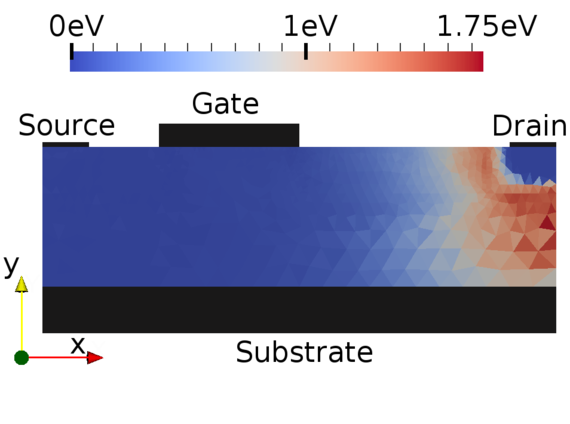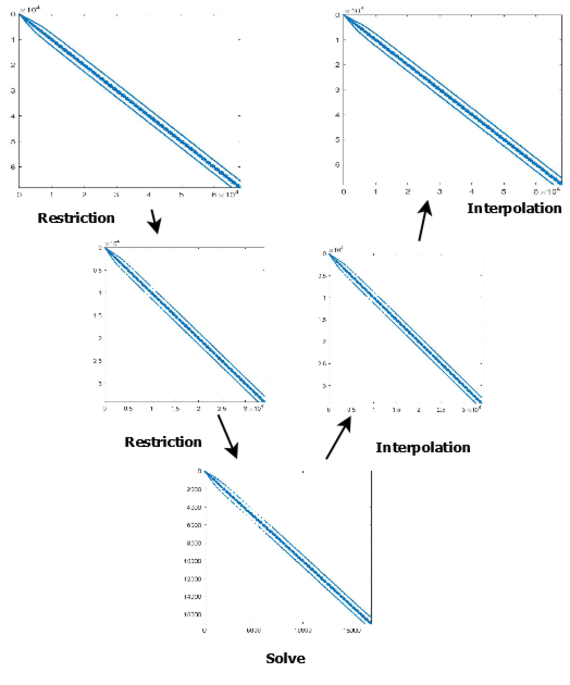 |
|
||||
BiographyFelipe was born in 1987 in Rio de Janeiro, Brazil. He received his Electronic and Computational Engineering degree from the Federal University of Rio de Janeiro in 2015. Subsequently, he studied Microelectronics at COPPE, where he wrote his Master's thesis at the Laboratório de Projeto de Circuitos, receiving his MSc. Degree in Electrical Engineering in 2018. After finishing his studies he joined the Institute for Microelectronics in January 2019, where he is currently working on his doctoral degree. Felipe is researching parallel numerical approaches for solving the Boltzmann Equation. |
|||||
Multigrid Solvers for the Boltzmann Equation
The Boltzmann transport equation (BTE) is a well-known equation that describes the behavior of a system of colliding particles. Many practical applications can be described by this equation, such as the modeling of fluid and gas transport and in our case the transport of the electrons and holes in semiconductor materials. Simpler models for semiconductors have begun to lose their validity because of the decrease in feature sizes in semiconductors, which increases the importance of solving the BTE directly. The BTE is a nonlinear partial differential equation in seven dimensions. This poses difficulties in solving this equation and requires sophisticated numerical methods, as well as a large amount of computing resources, ideally a supercomputer, such as the Vienna Scientific Cluster.
Three numerical methods are established in the scientific literature to solve the BTE, with each one requiring different parallelization strategies so that they may be used on a supercomputer. The first method is the Monte Carlo method, where the flight of electrons is computed inside the device, including their collisions with other carriers. This method has the advantage of being "embarrassingly parallel" and highly accurate, but its computational cost is huge. Another method is a finite-difference approach known as the weighted essentially non-oscillatory (WENO) scheme, which computes the density of electrons inside the device and resolves discontinuities of the collision operator. The WENO scheme can lead to numerically tractable and deterministic simulations, but it is considered to be limited to at most two-dimensional device geometries. Last but not least, the spherical harmonic expansions (SHE) method is a numerically performant deterministic solver in which the distribution function is expanded as a truncated series of spherical harmonics functions. This method is suitable for three-dimensional device geometries and provides a reduction in the execution time and memory requirements. For a two-dimensional simulation example, Fig. 1 shows the simulation of a laterally-diffused metal-oxide semiconductor (LDMOS) using SHE.
These methods can benefit from parallelization strategies, such as multigridding, for which several levels of detail are used to resolve all features of the solution on different scales, thus accelerating the overall solution procedure. The multigrid method can be divided into the two families of geometric and algebraic multigrid methods, where the distinction is based on how the multiple grids are established. In geometric multigrid, the mesh information is used to create a coarse grid and to solve a smaller problem on the coarser grid. This information is then used to solve the larger problem on the fine grid. In algebraic multigrid, the matrix information is used to create a smaller, linear problem. The solution of the smaller, linear problem is then used to solve the original matrix, which can be seen in Fig 2.

Fig. 1: The average carrier energy in an LDMOS structure computed by a SHE simulation.

Fig. 2: Representation of the V-grid with the SHE matrix.


